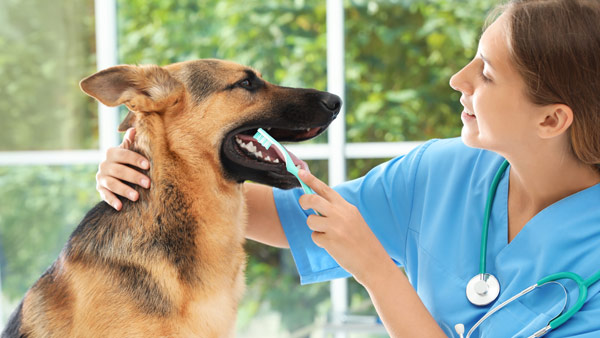
Just like in humans, unhealthy teeth and gums left untreated can lead to all sorts of other health issues like kidney problems, heart disease, among others. That’s why dental care is so important. According to the American Veterinary Dental College, most dogs and cats have some evidence of periodontal disease by the time they’re three years old. But, there are things you can do to manage your pet’s dental health and make sure their pearly whites (and gums) stay clean and healthy for many years to come.
What can I do at home to keep my pet’s teeth clean?
1. Start a routine and start it early. If you start cleaning your puppy or kitten’s teeth early, you’ll have a better chance of getting him or her used to having your fingers or a brush in their mouth. Plus, just like brushing your own teeth, working cleanings into a specific time of day can help you stick to it. Try brushing before you feed them in the morning or while you’re watching TV and cuddling in the evenings.
2. Choose what they chew. There are many synthetic bones or harder toys designed to help strengthen and clean your dog’s gums or teeth. Rawhides or other compressed chews can be beneficial, but also pose risks. Always monitor your dog while they’re chewing. If you’re not sure where to start, ask your vet to make some recommendations or you can refer to this list from the Veterinary Oral Health Council.
3. Feed them a good quality food. Generally speaking, crunchy food is better for your pet’s teeth than soft food, which is more likely to stick to the teeth and cause build-up and decay. There are also a number of food options for both dogs and cats that are designed to prevent plaque and tartar build-up.
4. Offer vegetables or fruit as treats. As with any treats, always offer these in moderation but things like carrots, brussels sprouts, chunks of squash or pumpkin won’t stick to your dog’s teeth like some processed treats will.
How does the vet take care of my pet’s teeth?
· Some vets will offer dental exams for free or at a low cost. Especially during February, which is Pet Dental Health Month, but sometimes all year, many clinics will offer free or lower cost dental exams. Check with your vet to see if this is something they offer.
· Teeth cleanings. If the vet determines teeth cleaning is needed, they’ll schedule another visit to do the procedure. With your pet under anesthesia; he or she (or a vet technician) will remove plaque and tartar with a special scaling tool, and will polish the teeth with a rubber-tipped polishing tool and toothpaste designed for dogs or cats. Your pet may get a fluoride treatment too. Sounds just like a trip to the dentist, right?
· Dental extractions. During the cleaning, your vet might determine that one or more teeth have too much disease and must be removed to protect the overall oral health of your pet. Sometimes extractions are fast and simple, especially if a tooth is already loose. Most dogs and cats adjust quite easily to eating with fewer teeth but in some cases, a special food may be needed.
Keep in mind, a dental cleaning done by anyone other than a licensed vet without anesthetic can be dangerous and unhealthy.
How to tell if my pet needs a dental cleaning
Regular exams of your pet’s mouth are important for catching dental disease in its early stages. Here are some other signs that may be related to dental disease:
· Bad breath
· Drooling more than usual
· Pawing at the mouth
· Difficulty chewing
· Loose or missing teeth
· Red or swollen gums
If you notice one or more of these symptoms, it may be time to schedule an appointment with your vet.
Petsecure plans can help with the cost of routine dental care
You can read more about what’s covered by Petsecure plans and get a free quote.
Want to share information about pet dental care with others? Share these tips on Facebook or Twitter.
